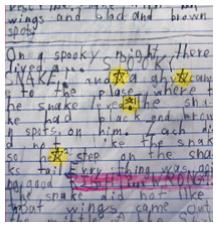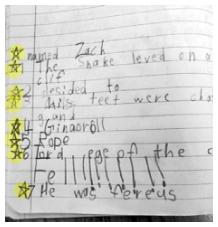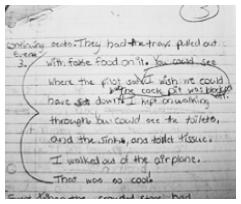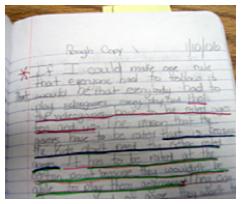If children are told to revise, it usually leads to corrected spelling and punctuation. We need to teach that revision means “to see again.”
– Donald Graves, Writing: Teachers and Children at Work
Add, subtract, combine or rearrange - without copying over!
Student writers are perfectionists, I’ve found. They don’t like to admit their paper needs any changes. They’re conditioned to make papers look neat. They’re not clear on what it means to sustain working on one paper over time. I explain plenty what revision is and how messy their paper is going to look until they make final drafts. Eventually, students accept that the final draft will be error free and that satisfies their need to hide their mistakes.
For modeling, my favorite tool is the DocCam so students can see real revising dilemmas. They can watch as a fellow classmate or I explain our revisions while the writing is projected onto a large screen. I post photos on SmartBoards to show first drafts, revisions, and changes, which makes the process very easy to see as well. Lacking technology, I model using the overhead projector or chart paper. Even for the overhead, I make a transparency of the actual writing to view. Revision is much easier to understand when the students see the real thing and do not have to think abstractly.
I share tips they can implement right away. Reading their essays or story out loud helps a writer determine what isn’t clear. If she keeps bumping up against a part that makes her wonder, should these words be here, the answer is most probably no. Take them out. Harder still is asking someone you trust to read the writing aloud to you just as it is written. But from listening to our stories read aloud to us, we are more likely to catch what needs to be fixed. Of course, students who take their drafts through fluid conference circles walk away with great suggestions as well.


Editing marks can aid additions
From the Chicago teachers who wrote Stack The Deck, I learned to teach students 4 ways to revise: add, subtract, rearrange and combine.
Adding is a great place to start. From their revision circles and conferences, writers know what to add. However, they don’t know how to add – without copying over. I show them. I show the real thing. I model how to fix minor problems by adding: writing in the margins and using a carat (^) to mark and write on the paper.
If the paper needs more additions than the margins can hold, I show them how to mark the places that need revision, number each place, and write the revisions on another sheet of paper with a corresponding number. Some children like to write on small sheets of paper and staple them to their first drafts. To the left, above, is an example where a second grader starred the places to add in the first photo. The photo to the right shows where he wrote out the revisions he was going to make in his final draft.


Similar process for combining
Combining works just the same way. Finding details that go together but are separated is also easy for my budding writers to understand. I show them how to draw arrows to remind themselves to move a detail or paragraph from one place to another. If they wrote on just the front of the paper, they can cut and paste to glue the details that go together in the same place. If they write on the computer, they actually cut and paste.
Rearranging
Finding an essay or story out of order is a bit more time-consuming to fix. I have to model, model, and model some more. I show students how to get the essay or story in order by:
- Cutting and pasting.
- Color-coding. They underline the sentences that go together with color. All the sentences about going to the football game are underlined in one color. Underline the sentences about the cheerleaders in another color, etc. If the writer discovers sentences that don’t fit anywhere, they don’t get underlines at all. Step back. When rewriting, putting all the same colored sentences together. Check again to see whether the writing is clear or needs more revision work.
- On the computer, sentences and words can be arranged easily but still must be modeled.
Subtracting
Finally – I teach my students to subtract. Of course, they know how to find minor subtraction revisions like taking out a word they’ve repeated. But real subtraction, deep surgery on a story or essay is something with which mature writers struggle. I tell them that if they can take out information that doesn’t belong, they have arrived as writers. It’s not easy to part with favorite words, phrases or whole parts of stories or paragraph of essays. But, sometimes the details just don’t belong. Simpler is always better when in doubt. It’s easy physically because they just cross out. But what needs to go is difficult to find in your own paper.
There is some good news, though. The parts a writer removes can turn into other stories or essays. So, I advise students not to throw them away. Cut the details out and paste them (or copy them) in their daybooks for writing in the future.
Next: Editing